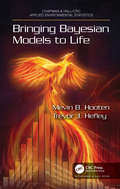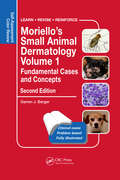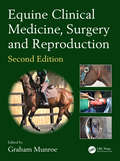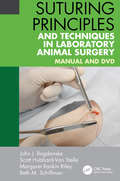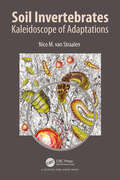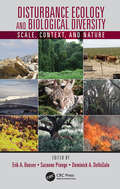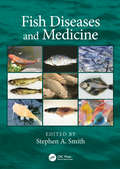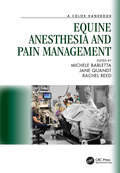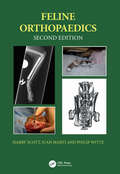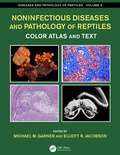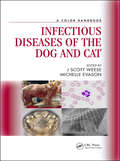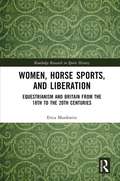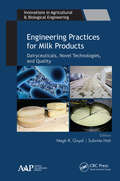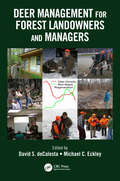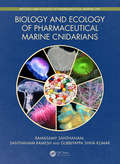- Table View
- List View
Bringing Bayesian Models to Life (Chapman & Hall/CRC Applied Environmental Statistics)
by Mevin B. Hooten Trevor J. HefleyBringing Bayesian Models to Life empowers the reader to extend, enhance, and implement statistical models for ecological and environmental data analysis. We open the black box and show the reader how to connect modern statistical models to computer algorithms. These algorithms allow the user to fit models that answer their scientific questions without needing to rely on automated Bayesian software. We show how to handcraft statistical models that are useful in ecological and environmental science including: linear and generalized linear models, spatial and time series models, occupancy and capture-recapture models, animal movement models, spatio-temporal models, and integrated population-models. Features: R code implementing algorithms to fit Bayesian models using real and simulated data examples. A comprehensive review of statistical models commonly used in ecological and environmental science. Overview of Bayesian computational methods such as importance sampling, MCMC, and HMC. Derivations of the necessary components to construct statistical algorithms from scratch. Bringing Bayesian Models to Life contains a comprehensive treatment of models and associated algorithms for fitting the models to data. We provide detailed and annotated R code in each chapter and apply it to fit each model we present to either real or simulated data for instructional purposes. Our code shows how to create every result and figure in the book so that readers can use and modify it for their own analyses. We provide all code and data in an organized set of directories available at the authors' websites.
Moriello's Small Animal Dermatology Volume 1, Fundamental Cases and Concepts: Self-Assessment Color Review, Second Edition (Veterinary Self-Assessment Color Review Series)
by Darren BergerKaren Moriello's seminal book has been completely updated in an effort to create a true two-volume set highlighting fundamental and advanced concepts. This revised fundamental edition includes all new cases and nearly 300 new images. The guide uses a case-based format to deliver a general overview of dermatology of the dog and cat, providing a reference that mirrors the way veterinarians will encounter different scenarios at random in real-life practice. It uses self-assessment problems to review the most common skin diseases encountered every day, plus some more obscure diseases that a veterinarian will face.
Equine Clinical Medicine, Surgery and Reproduction
by Graham MunroeThis fully-revised new edition of the best-selling Equine Clinical Medicine, Surgery and Reproduction is supported by over 1800 illustrations of the highest quality: colour photographs, diagnostic images including MRI and CT, and diagrams. System-based, the chapters introduce each individual system with precise information on the relevant basic anatomy and physiology, standard clinical examination techniques and useful differential diagnostic aids. This is followed by diseases and disorders that are pertinent to that system, grouped together either anatomically or based on presenting clinical signs. Each condition is described using consistent headings: definition/overview, etiology and pathophysiology, clinical presentation, diagnosis, differential diagnoses, management/treatment, and prognosis. Additional chapters deal with the foal and wounds. New to the second edition: - All chapters are updated throughout - Additional chapters on the axial musculoskeletal system (neck, back and pelvis) and muscle diseases and problems - A whole new section on soft tissue injuries of the foot - More information on diagnostic tests including over-ground endoscopy, chest and liver ultrasonography, head CT, and foot MRI - Material on equine dentistry, neurology, endocrine system, the foal, and the liver has been considerably expanded - All illustrations and photographs have been reviewed and many replaced with higher quality images. The focus throughout remains on providing clinically relevant information required for practical case management, plus sufficient background on causes and disease processes to enable readers to understand the conditions and the rationale for diagnostic and treatment options. An international group of respected clinicians have come together under the editorship of Dr Graham Munroe to create a textbook that will be of lasting value as a teaching and training resource for equine clinical teachers and their students in veterinary medicine and related equine courses, as well as a ready reference for non-specialist mixed or equine clinical practitioners
Foot and Mouth Disease: Current Perspectives
by Francisco Sobrino and Esteban DomingoThe shock following the recent outbreak of foot-and-mouth disease (FMD) in the UK dispelled the notion that this disease was permanently under control and could be forgotten. FMD proved to be an endemic disease in many countries and continues to pose a major threat to animal health worldwide. The development of more effective and socially acceptabl
Global Plant Genetic Resources for Insect-Resistant Crops
by Stephen L. ClementAn excellent reference book for plant breeders and entomologists, Global Plant Genetic Resources for Insect-Resistant Crops combines germplasm preservation with use in insect-resistant crop development and basic research. The contributions of the authors represent the efforts, cooperation, and understanding of world leaders in the conservation and use of global plant genetic resources for sustainable agricultural production. Concepts addressed include dependency of modern agriculture on chemical pest control and applications of biotechnology in use of natural plant genes for insect-resistant crops. Marketing Class Code: 1E, 1G, 9C
Suturing Principles and Techniques in Laboratory Animal Surgery: Manual and DVD
by John J. BogdanskeSuturing Principles and Techniques in Laboratory Animal Surgery: Manual and DVD introduces the basic principles of, and the materials and instruments required for, suturing and wound closure on animals in a research or veterinary facility. The manual provides descriptions and pictures portraying proper tissue handling and aseptic technique during w
Soil Invertebrates: Kaleidoscope of Adaptations
by Nico M. van StraalenSoil invertebrates make up diverse communities living in soil pores and on the soil surface, digging burrows and tunnels, processing organic matter and interacting with microbes. Soil is also a habitat of growing concern as many human activities cause soil degradation. This book documents the evolutionary history of soil invertebrates and their multitude of adaptations. Soil invertebrates live in a twilight zone: some have gone down to seek stability, constancy and rest, others have gone up and faced environmental variation, heat, cold and activity. And it all happens in a few decimetres, millimetres sometimes. Check out the wonderful life below ground in this book.
Beneficial Insects
by David V. AlfordInsects are key components of life on our planet, and their presence is essential for maintaining balanced terrestrial ecosystems. Without insects humans would struggle to survive, and on a world scale food production would be severely compromised. Many plants and animals depend directly or indirectly on insects for their very survival, and this is particularly so in the case of insectivorous birds and other such creatures. The beneficial role of insects is often overlooked or misunderstood, and in farming circles their very presence on crops is often seen to be unwelcome. In reality, however, many insects are genuinely beneficial, as in the case of parasitic and predacious species. The use of chemical pesticides to control crop pests is becoming more tightly regulated and environmentally undesirable, and low-input farming, in which natural enemies of pests are encouraged to survive or increase, is becoming far more prevalent. Accordingly, Integrated Pest Management (IPM) and Integrated Pest Management (ICM) strategies are increasingly being developed, advocated and adopted. Features: Highlights information on many groups of insects and mites that act as natural enemies or biological control agents of phytophagous insects and mites, including plant pests. Profusely illustrated with high-quality colour photographs. Focuses mainly on insects and mites as natural enemies of plant pests, including parasitic and predacious species that have been accidentally or deliberately introduced in classical biological control programmes. Reviews the role of phytophagous European insects and mites in controlling or managing European plants that have become invasive weeds in other parts of the world, notably North America, Australia and New Zealand.
Disturbance Ecology and Biological Diversity: Context, Nature, and Scale
by Erik A. Beever Inger Suzanne Prange Dominick A. DellaSalaThis book presents cascading effects of ecological disturbances on a multitude of ecosystem components. It includes agricultural development, large infrequent disturbances, forest harvesting, non-native grazing in deserts, ground transportation, powerline corridors, fires, urban ecology, disturbance in aquatic ecosystems, land-use dynamics on diversity, habitat fragmentation, sedimentation of wetlands, and contemporary climate change. The book facilitates users in understanding why disturbances are occurring while recommending mitigation and remediation strategies.
Fish Diseases and Medicine
by Stephen A. SmithFish are critically important to the welfare of this planet and its occupants, the health of both wild and captive fish populations paramount to our survival. This book presents the gross pathology of the most commonly encountered diseases and syndromes of fish in an organ system-based approach. It provides an overview of the di
Equine Anesthesia and Pain Management: A Color Handbook (Veterinary Color Handbook Series)
by Michele Barletta Jane Quandt Rachel ReedEquine Anesthesia and Pain Management: A Color Handbook brings together key information for clinicians in an easy-to-use, problem-orientated format. It disseminates a wealth of knowledge about horse, donkey and mule anesthesia and pain management in a quick reference style, with a focus on clinical practice. Fifteen chapters by expert contributors cover everything from anesthetic equipment, premedication and physical restraint, to total intravenous anesthesia, inhalant anesthesia and partial intravenous anesthesia, recovery, complications and euthanasia. Over 250 superb color photographs and diagrams bring the material to life. This book will be invaluable to all those who need practical information easily to hand, whether equine practitioner, veterinary technician or nurse, or veterinary student.
Feline Orthopaedics
by Harry Scott Juan M. Marti Philip WitteCats are not referred to specialists as frequently as dogs, meaning the general practitioner must routinely treat cats that have been involved in road traffic accidents and other musculoskeletal trauma. This book is the first of its kind to provide a practical and user-friendly guide to feline orthopaedics. With a new author team, led by RCVS Specialist in Small Animal Surgery (Orthopaedics) and Veterinary Neurology Harry Scott, the second edition has been thoroughly revised and updated. New chapters cover Physiotherapy and Oncology of the Feline Skeletal System. The book includes highly structured fully referenced text that provides a concise, straightforward guide to the recognition and management of specific diseases and conditions. In this new edition, the neurological causes of lameness have been given more in-depth discussion, with an emphasis on early recognition of clinical signs and diagnosis. The disorder sections are now divided into those likely to be associated with trauma (fractures and luxation) and those which are congenital or developmental. The text is supported by high quality radiographs, colour photographs and colour line drawings to illustrate principles, techniques and procedures. Combining their experience in practice and education, the authors have produced a book that appeals to general practice veterinarians, specialist feline practitioners and to students.
Noninfectious Diseases and Pathology of Reptiles: Color Atlas and Text, Diseases and Pathology of Reptiles, Volume 2
by Michael M. Garner and Elliott R. JacobsonThis book accompanies Infectious Diseases and Pathology of Reptiles, Second Edition to cover noninfectious diseases of reptiles, meeting the need for a similar, authoritative single-source reference. The volume features color photos of normal anatomy and histology, as well as gross, light, and electron microscopic imagery of diseases. Subjects range from neoplasia, nutrition, and metabolic disease, and deposition disorders to developmental anomalies, trauma, and physical diseases, and the unique contribution of paleopathology and diseases of bone. Each chapter is supported by numerous figures, many of which are unique and cannot be found in the published literature. Readers will note that some of the chapters are based on organ system, a trend that will continue into the next edition to encompass all of the basic organ systems. This book holds the most information ever accrued into one publication on noninfectious diseases and pathology of this class of animals, providing information on every aspect of the anatomy, pathophysiology, and differential diagnosis. With up-to-the-minute data, a never-before-seen collection of images, and a stellar panel of contributors, Noninfectious Diseases and Pathology of Reptiles is the definitive resource for veterinarians, biologists, and researchers involved in the study of reptile diseases.
Infectious Diseases of the Dog and Cat: A Color Handbook
This is a concise and quick reference guide, clinically oriented, based on experience underpinned by published research data. The systems-based approach emphasizes the problem list process utilized by most practitioners when faced with a patient presenting with a single or variety of clinical symptoms. This allows generation of a complete list of infectious disease differentials, and the ability to include or exclude those indicated based on patient risk assessment. Pathogen specific information enables rational choice of diagnostics, therapy, and prognostication for a complete list of small animal infectious disease that includes bacterial, viral, parasitic/protozoal and fungal.
Health and Welfare of Brachycephalic (Flat-faced) Companion Animals: A Complete Guide for Veterinary and Animal Professionals
by Rowena Packer Dan O'NeillHealth and welfare issues of brachycephalic (flat-faced) animals are one of the most pressing problems facing companion animals right now. Dogs, in particular, are suffering from a ‘brachycephalic crisis’ resulting from a perfect storm where predispositions to an array of health issues are amplified by a population boom for certain brachycephalic breeds such as the French Bulldog and Pug. But yet, for many owners, these dogs represent the perfect companion: endearing personas and cute looks in a socially desirable package. So where is the truth in all of this? This book will equip veterinary professionals, animal welfare scientists, breeders and owners with the fuller story about brachycephalic health and welfare. The first half of the book provides the context of how and why we are in this crisis, offering in-depth historical, social, ethical, communication, nursing, welfare, epidemiological, genetics and international perspectives. The second half shifts towards the clinical arena, with chapters that cover the background, diagnosis, treatment and prevention of the many unique healthcare needs of brachycephalic animals. Cutting-edge knowledge is shared on a range of disciplines including respiratory disease, ophthalmology, dermatology, dentistry, neurology, obesity, reproduction and anesthesia. With twenty chapters written by world-leading experts, lifetimes of experience and knowledge are condensed into the first book dedicated exclusively to brachycephaly in companion animals. This essential reference resource will inform, challenge and stimulate; it will open your mind to new opportunities for you to improve the welfare of brachycephalic animals by your personal and collective choices and actions. But prepare to be surprised: you may just find that your views on brachycephaly in companion animals will be changed forever.
Women, Horse Sports and Liberation: Equestrianism and Britain from the 18th to the 20th Centuries (Routledge Research in Sports History)
by Erica MunkwitzThis book is the first, full-length scholarly examination of British women’s involvement in equestrianism from the eighteenth through the twentieth centuries, as well as the corresponding transformations of gender, class, sport, and national identity in Britain and its Empire. It argues that women’s participation in horse sports transcended limitations of class and gender in Britain and highlights the democratic ethos that allowed anyone skilled enough to ride and hunt – from chimney-sweep to courtesan. Furthermore, women’s involvement in equestrianism reshaped ideals of race and reinforced imperial ideology at the zenith of the British Empire. Here, British women abandoned the sidesaddle – which they had been riding in for almost half a millennium – to ride astride like men, thus gaining complete equality on horseback. Yet female equestrians did not seek further emancipation in the form of political rights. This paradox – of achieving equality through sport but not through politics – shows how liberating sport was for women into the twentieth century. It brings into question what “emancipation” meant in practice to women in Britain from the eighteenth through twentieth centuries. This is fascinating reading for scholars of sports history, women's history, British history, and imperial history, as well as those interested in the broader social, gendered, and political histories of the nineteenth and twentieth centuries, and for all equestrian enthusiasts.
Engineering Practices for Milk Products: Dairyceuticals, Novel Technologies, and Quality (Innovations in Agricultural & Biological Engineering)
by Megh R. Goyal Subrota HatiWhile also addressing the need for more effective processing technologies for increased safety and quantity, the dairy industry needs to address the growing customer demand for new and innovative dairy foods with enhanced nutritional value. This volume looks at new research, technology, and applications in the engineering of milk products, specifically covering functional bioactivities to add value while increasing the quality and safety of milk and fermented milk products. Chapters in the book look at the functional properties of milk proteins and cheese, functional fermented milk-based beverages, biofunctional yoghurt, antibiotic resistant pathogens, and other probiotics in dairy food products.
Health and Welfare of Brachycephalic (Flat-faced) Companion Animals: A Complete Guide for Veterinary and Animal Professionals
by Dr Rowena M. A. Packer Dr Dan G. O’NeillHealth and welfare issues of brachycephalic (flat-faced) animals are one of the most pressing problems facing companion animals right now. Dogs, in particular, are suffering from a ‘brachycephalic crisis’ resulting from a perfect storm where predispositions to an array of health issues are amplified by a population boom for certain brachycephalic breeds such as the French Bulldog and Pug. But yet, for many owners, these dogs represent the perfect companion: endearing personas and cute looks in a socially desirable package. So where is the truth in all of this? This book will equip veterinary professionals, animal welfare scientists, breeders and owners with the fuller story about brachycephalic health and welfare. The first half of the book provides the context of how and why we are in this crisis, offering in-depth historical, social, ethical, communication, nursing, welfare, epidemiological, genetics and international perspectives. The second half shifts towards the clinical arena, with chapters that cover the background, diagnosis, treatment and prevention of the many unique healthcare needs of brachycephalic animals. Cutting-edge knowledge is shared on a range of disciplines including respiratory disease, ophthalmology, dermatology, dentistry, neurology, obesity, reproduction and anesthesia. With twenty chapters written by world-leading experts, lifetimes of experience and knowledge are condensed into the first book dedicated exclusively to brachycephaly in companion animals. This essential reference resource will inform, challenge and stimulate; it will open your mind to new opportunities for you to improve the welfare of brachycephalic animals by your personal and collective choices and actions. But prepare to be surprised: you may just find that your views on brachycephaly in companion animals will be changed forever.
Women, Horse Sports and Liberation: Equestrianism and Britain from the 18th to the 20th Centuries (Routledge Research in Sports History)
by Erica MunkwitzThis book is the first, full-length scholarly examination of British women’s involvement in equestrianism from the eighteenth through the twentieth centuries, as well as the corresponding transformations of gender, class, sport, and national identity in Britain and its Empire. It argues that women’s participation in horse sports transcended limitations of class and gender in Britain and highlights the democratic ethos that allowed anyone skilled enough to ride and hunt – from chimney-sweep to courtesan. Furthermore, women’s involvement in equestrianism reshaped ideals of race and reinforced imperial ideology at the zenith of the British Empire. Here, British women abandoned the sidesaddle – which they had been riding in for almost half a millennium – to ride astride like men, thus gaining complete equality on horseback. Yet female equestrians did not seek further emancipation in the form of political rights. This paradox – of achieving equality through sport but not through politics – shows how liberating sport was for women into the twentieth century. It brings into question what “emancipation” meant in practice to women in Britain from the eighteenth through twentieth centuries. This is fascinating reading for scholars of sports history, women's history, British history, and imperial history, as well as those interested in the broader social, gendered, and political histories of the nineteenth and twentieth centuries, and for all equestrian enthusiasts.
Engineering Practices for Milk Products: Dairyceuticals, Novel Technologies, and Quality (Innovations in Agricultural & Biological Engineering)
by Megh R. Goyal Subrota HatiWhile also addressing the need for more effective processing technologies for increased safety and quantity, the dairy industry needs to address the growing customer demand for new and innovative dairy foods with enhanced nutritional value. This volume looks at new research, technology, and applications in the engineering of milk products, specifically covering functional bioactivities to add value while increasing the quality and safety of milk and fermented milk products. Chapters in the book look at the functional properties of milk proteins and cheese, functional fermented milk-based beverages, biofunctional yoghurt, antibiotic resistant pathogens, and other probiotics in dairy food products.
Deer Management for Forest Landowners and Managers
by David S. deCalesta and Michael C. EckleyThis book is designed to help landowners and forestry professionals develop, implement, and monitor programs to manage both deer and forests with emphasis on resolving deer impact issues. Chapters cover management strategies through identifying and setting goals; managing deer populations and deer impact on land; economics of forest, deer, and impact management; human dimensions of deer management; and developing and implementing integrated management plans. The book presents an integrated, quantitative approach for managing deer populations and impacts so users can manage forest resources sustainably.
Biology and Ecology of Pharmaceutical Marine Cnidarians (Biology and Ecology of Marine Life)
by Ramasamy Santhanam Santhanam Ramesh Gubbiyappa Shiva KumarThe first comprehensive book on the biology and ecology of pharmaceutical cnidarians, answering a need for more knowledge about the identification, biology, natural products and bioactivities of these living resources. Contributed by scientists of both marine biology and pharmacy disciplines. Identifies the correct marine species, shows the ecological parameters of that species, and explores its biological values with particular attention to primary and secondary metabolites or bioactive constituents. A useful supplementary text on Marine Biology and Pharmacology courses. Nearly 200 illustrations are produced in full color, providing a high-quality reference. This book provides the taxonomy, common name, global distribution, habitat, diagnostic features, and pharmaceutical compounds (along with their activities) of 200 species of marine cnidarians along with nearly 200 detailed illustrations in glorious color. The phylum Cnidaria (formerly Coelenterata) is a large, diverse, and ecologically important group of marine invertebrates which make up 40 percent of the biomass of the oceans. Marine invertebrates are the richest source of marine natural products with potential applications in the pharmaceutical and medical sectors, and it has been reported that over 3000 bioactive compounds have been described from this phylum alone, mostly in the last decade.
Biology and Ecology of Pharmaceutical Marine Cnidarians (Biology and Ecology of Marine Life)
by Ramasamy Santhanam Santhanam Ramesh Gubbiyappa Shiva KumarThe first comprehensive book on the biology and ecology of pharmaceutical cnidarians, answering a need for more knowledge about the identification, biology, natural products and bioactivities of these living resources. Contributed by scientists of both marine biology and pharmacy disciplines. Identifies the correct marine species, shows the ecological parameters of that species, and explores its biological values with particular attention to primary and secondary metabolites or bioactive constituents. A useful supplementary text on Marine Biology and Pharmacology courses. Nearly 200 illustrations are produced in full color, providing a high-quality reference. This book provides the taxonomy, common name, global distribution, habitat, diagnostic features, and pharmaceutical compounds (along with their activities) of 200 species of marine cnidarians along with nearly 200 detailed illustrations in glorious color. The phylum Cnidaria (formerly Coelenterata) is a large, diverse, and ecologically important group of marine invertebrates which make up 40 percent of the biomass of the oceans. Marine invertebrates are the richest source of marine natural products with potential applications in the pharmaceutical and medical sectors, and it has been reported that over 3000 bioactive compounds have been described from this phylum alone, mostly in the last decade.
Reproduction and Development in Annelida (Reproduction and Development in Aquatic Invertebrates)
by T. J. PandianThis book is a concise informative elucidation of all aspects of reproduction and development in annelids covering from arenicola to tubifex. Annelids flourish between 4,900 m depth to 2,000 m altitude; some of them occur in unusual habitats like hydrothermal vents and subterranean aquatic system (stigobionts). A few have no gut and acquire adequate nutrients through osmotrophism and/or engaging symbiotic microbes. In the absence of exoskeleton to escape predation, the 17,000 speciose annelids have explored bewildering modes of reproduction; not surprisingly, 42–47% of them are brooders. With 13,000 species, polychaetes are gonochores but some 207 species of them are hermaphrodites. Clitellates are all hermaphrodites; of them, 76 species are parthenogens, of which 56 are earthworms. Regenerative potency of annelids ranges from an organ to an entire worm from a single ‘seminal’ segment. The head, tail and both together can be regenerated 21, 42 and 20 times, respectively. However, the potency is limited to ~1% of polychaetes and Heterogamatic sex determination is reported to occur only in six polychaete species, although karyotype is known for 83 annelid species. In temperate polychaetes, a dozen neuroendocrines, arising mostly from the ‘brain’ regulates reproductive cycle. A complete chapter devoted to vermiculture, (i) recognizes the fast-growing candidate species, (ii) distinguishes 'layers' from 'brooders', (iii) indicates that the harvest of oligochaetes may reduce the input of nitrogenous fertilizer in the ricefield, and (iv) explores the scope for increasing wealth from waste.
Reproduction and Development in Annelida (Reproduction and Development in Aquatic Invertebrates)
by T. J. PandianThis book is a concise informative elucidation of all aspects of reproduction and development in annelids covering from arenicola to tubifex. Annelids flourish between 4,900 m depth to 2,000 m altitude; some of them occur in unusual habitats like hydrothermal vents and subterranean aquatic system (stigobionts). A few have no gut and acquire adequate nutrients through osmotrophism and/or engaging symbiotic microbes. In the absence of exoskeleton to escape predation, the 17,000 speciose annelids have explored bewildering modes of reproduction; not surprisingly, 42–47% of them are brooders. With 13,000 species, polychaetes are gonochores but some 207 species of them are hermaphrodites. Clitellates are all hermaphrodites; of them, 76 species are parthenogens, of which 56 are earthworms. Regenerative potency of annelids ranges from an organ to an entire worm from a single ‘seminal’ segment. The head, tail and both together can be regenerated 21, 42 and 20 times, respectively. However, the potency is limited to ~1% of polychaetes and Heterogamatic sex determination is reported to occur only in six polychaete species, although karyotype is known for 83 annelid species. In temperate polychaetes, a dozen neuroendocrines, arising mostly from the ‘brain’ regulates reproductive cycle. A complete chapter devoted to vermiculture, (i) recognizes the fast-growing candidate species, (ii) distinguishes 'layers' from 'brooders', (iii) indicates that the harvest of oligochaetes may reduce the input of nitrogenous fertilizer in the ricefield, and (iv) explores the scope for increasing wealth from waste.
